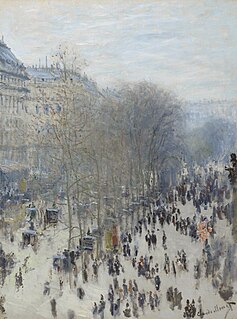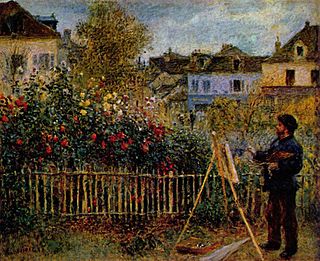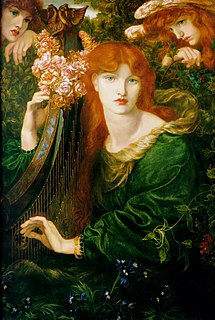 W
WArrangement in Grey and Black, No. 2: Portrait of Thomas Carlyle is an 1872–73 oil painting by James McNeill Whistler. It depicts the Scottish social critic, philosopher and historian Thomas Carlyle in a composition similar to that of Whistler's 1871 Arrangement in Grey and Black No. 1: Portrait of the Artist's Mother, commonly known as Whistler's Mother. It is now in the Kelvingrove Art Gallery and Museum in Glasgow, Scotland.
 W
WAstronomer Copernicus, or Conversations with God is an oil painting by the Polish artist Jan Matejko, finished in 1873, depicting Nicolaus Copernicus observing the heavens from a balcony by a tower near the cathedral in Frombork. Currently the painting is in the collection of the Jagiellonian University of Kraków, which purchased it from a private owner with money donated by the Polish public.
 W
WThe Banks of the Oise near Pontoise is an 1873 oil painting by French artist Camille Pissarro, located in the Indianapolis Museum of Art, which is in Indianapolis, Indiana. It depicts the river Oise near the market town of Pontoise.
 W
WBarge Haulers on the Volga or Burlaki is an 1870–1873 oil-on-canvas painting by artist Ilya Repin. It depicts 11 men physically dragging a barge on the banks of the Volga River. They are at the point of collapse from exhaustion, oppressed by heavy, hot weather.
 W
WA Basket of Clams is a mid-19th century watercolor by American artist Winslow Homer in the collection of the Metropolitan Museum of Art in New York City.
 W
WThe Boat Builders is an oil painting on panel by American landscape painter Winslow Homer, which is held in the collection of the Indianapolis Museum of Art (IMA), in Indianapolis, Indiana, United States.
 W
WBoulevard des Capucines is an oil on canvas street scene painting of the famous Paris boulevard by French Impressionist artist Claude Monet created in 1873.
 W
WBoys in a Dory is a mid 19th-century painting by American artist Winslow Homer. Done in watercolor and gouache on wove paper, the painting depicts a group of boys boating in a dory. Winslow's work is in the collection of the Metropolitan Museum of Art.
 W
WChemin de la Machine, Louveciennes or 'Route de Sèvres near Louveciennes is an 1873 painting by Alfred Sisley. Exhibited at the Exposition Universelle of 1900, it entered the Louvre in 1918 from the collection of Joanny Peytel and has been in the Musée d'Orsay since 1986.
 W
WClaude Monet Painting in His Garden at Argenteuil is an 1873 Impressionist painting by Pierre-Auguste Renoir.
 W
WA Cotton Office in New Orleans, also known as Interior of an Office of Cotton Buyers in New Orleans and Portraits in an Office , is an oil painting by Edgar Degas. Degas depicts the interior of his maternal uncle Michel Musson's cotton firm in New Orleans. Musson, Degas's brothers René and Achille, Musson's son-in-law William Bell, and other associates of Musson are shown engaged in various business and leisure activities while raw cotton rests on a table in the middle of the office.
 W
WThe Croquet Game is an 1873 oil on canvas painting by Édouard Manet, now in the Städel Museum in Frankfurt. It shows a group of people playing croquet, a very fashionable game at that time. The group comprises the painter Alfred Stevens, artists' models Victorine Meurent and Alice Legouvé and, in the background, Manet's friend Paul Rodier.
 W
WFrost in Louveciennes is an 1873 painting by Alfred Sisley, which has been in the Pushkin Museum since 1948. It shows the church of St Martin in the French town of Louveciennes. A chalk sketch for it is now in the Budapest Museum of Fine Arts.
 W
WLa Ghirlandata ("The Garlanded Woman") is an 1873 painting by English painter and poet Dante Gabriel Rossetti. It is currently in the collection of the Guildhall Art Gallery in London, United Kingdom. The model who sat for the painting was Alexa Wilding. May Morris was the model for both angel heads in the top corners of the painting.
 W
WThe Hanged Man's House is an 1873 oil on canvas painting by Paul Cézanne. The painting is exhibited at the Musée d'Orsay in Paris.
 W
WThe Last Cartridges is an 1873 painting by the French artist Alphonse de Neuville.
 W
WLigeia Siren is a chalk drawing by Dante Gabriel Rossetti (DGR) that was completed in 1873. The painting depicts a siren, a creature from classic Greek mythology, that also appear in tales such as Homer's Odyssey or Virgil's Georgics. The drawing is predominantly inspired from Rossetti's own 1869 libretto The Doom of the Sirens with which Ligeia is one of the female leads. Instead of depicting the traditional encounter of the siren with her victims entranced by her beauty and powers of music, doomed to a terrible fate, as in The Siren (1900) by John William Waterhouse or Ulysses and the Sirens (1909) by Herbert James Draper. Rossetti depicts a timeless moment, where contrary to his depiction of her in his libretto, she appears tranquil and relatively innocuous to her intended victims in the background.
 W
WLove Among the Ruins is a painting by English artist Edward Burne-Jones which exists in two versions, a watercolour completed in 1873 and an oil painting completed in 1894. It depicts a man and a woman amid ruined architecture. The work is a synthesis of influences from the Pre-Raphaelite, Symbolist and Aesthetic art movements. The ambiguous scene without a clear narrative is considered one of Burne-Jones' best works.
 W
WMasked Ball at the Opera House is a painting by Édouard Manet, produced in spring 1873. It is now in the National Gallery of Art, to which it was offered by Mrs. H. Havemayer in 1982.
 W
WNair lady Adorning Her Hair is an 1873 painting by Raja Ravi Varma. The painting depicts a domestic scene in which a Nair woman adorning her hair with a garland of flowers in front of a mirror. The painting was notable for being the first major award-winning work that Ravi Varma had completed. Receiving praise at the international and national level, the painting had brought the young Ravi Varma into the attention of the global artistic community, as well as leading him on to later become one of the most well known modern Indian painters.
 W
WNødhavn Ved Norskekysten is a painting by Norwegian romanticist painter Hans Gude completed in 1873.
 W
WNymphs and Satyr is a painting, oil on canvas, created by artist William-Adolphe Bouguereau in 1873.
 W
WThe Railway, widely known as Gare Saint-Lazare, is an 1873 painting by Édouard Manet. It is the last painting by Manet of his favourite model, the fellow painter Victorine Meurent, who was also the model for his earlier works Olympia and the Luncheon on the Grass. It was exhibited at the Paris Salon in 1874, and donated to the National Gallery of Art in Washington, D.C. in 1956.
 W
WRoger Freeing Angelica is an oil painting by Swiss symbolist painter Arnold Böcklin, from 1873. The painting illustrates a scene from Ariosto's epic Orlando Furioso, in which the Muslim knight Roger saves the pagan princess Angelica from a sea monster. The motif is closely related to the mythological theme of Perseus saving Andromeda.
 W
WRoman Carts is an 1872-73 tempera on canvas painting by Giovanni Fattori, painted during a stay in Rome. It is now in the Galleria d'Arte Moderna in Florence, Italy.
 W
WThe Seine at Argenteuil is an 1873 oil painting by Claude Monet, one of a series of paintings the artist made of the area.
 W
WThe Seine at Asnières is an 1873 oil on canvas painting by Claude Monet, now in the Hermitage Museum in St Petersburg. It was previously in the collection of Alice Meyer, widow of the extremely rich Hamburg businessman Eduard Lorenz Lorenz-Meyer (1856-1926) before being looted by the USSR after World War Two and retained as war reparations. It has been on public display since an exhibition in 1995.
 W
WThe Shadow of Death is a religious painting by William Holman Hunt, on which he worked from 1870 to 1873, during his second trip to the Holy Land. It depicts Jesus as a young man prior to his ministry, working as a carpenter. He is shown stretching his arms after sawing wood. The shadow of his outstretched arms falls on a wooden spar on which carpentry tools hang, creating a "shadow of death" prefiguring the crucifixion. His mother Mary is depicted from behind, gazing up at the shadow, having been looking into a box in which she has kept the gifts given by the Magi.
 W
WSpringtime is a mid-19th century painting by French artist Pierre Auguste Cot. Done in oil on canvas, the painting is currently in the collection of the Metropolitan Museum of Art.
 W
WSurrender of a Confederate Soldier is an 1873 painting by Julian Scott in the collection of the Smithsonian American Art Museum. The painting depicts an injured soldier of the Confederate States Army in the American Civil War waiving an improvised flag of surrender. The soldier is accompanied by black man and a woman holding an infant: the black man is presumed to be the soldier's slave, and the woman and infant are presumed to be his wife and child.
 W
WTarring a Boat is an 1873 painting by Édouard Manet, painted at Berck beach during one of his regular summer stays in Boulogne-sur-Mer. It shows the hull of a fishing boat being tarred. In it he used a darker palette than usual, typical of his work of that period. It is now in the Barnes Foundation.
 W
WThe Bath is an oil on canvas painting by Belgian painter Alfred Stevens.
 W
WThe Unwelcome Companion: A Street Scene in Cairo is an early painting by John William Waterhouse. Completed in 1873, it was exhibited at the gallery of the Society of British Artists.